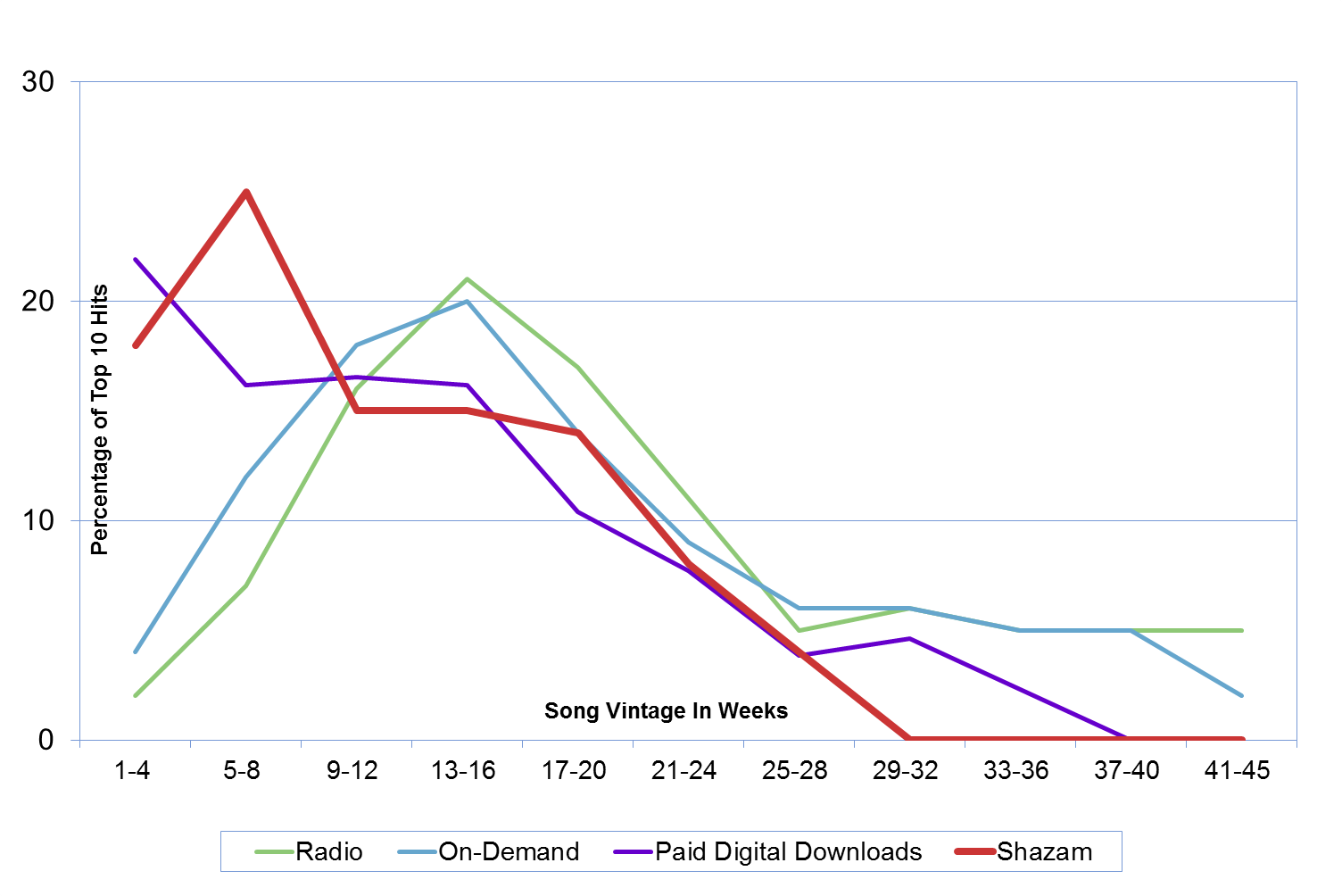This is the fifth and final post in a series about how listeners engage with music across traditional and emerging platforms
Shazam, the popular app that tells users the artist and title of just about any song wherever they hear it, is the latest tool raising programmer’s hopes of discovering which new releases will ultimately become big hits. Shazam’s own CEO claims his service can identify hits months before they become hits anywhere else.
Our analysis of 16 weeks of U.S. Shazam charts reveals that 75% of the Top 10 most Shazamed songs in the U.S. are 16 weeks old or less, with songs most likely to be among the Top 10 songs on Shazam between 5 and 8 weeks. That’s after song sales peak, but before the 9- to 20-week timeframe when radio exposure and on-demand plays peak. Thus, while songs do typically peak on Shazam before they peak on radio, the difference is measured in weeks, not months.
Songs tend to peak on Shazam after sales but before radio exposure and on-demand listening. © 2014-2015 Billboard Magazine, Shazam Entertainment Limited
How can you use Shazam to help your station stay on top of new music? Here are five factors you should consider when examining Shazam for guidance on selecting new music
1) People only Shazam songs when they don’t know them yet. It would be a mistake to assume your listeners no longer wish to hear a song simply because Shazam users are no longer Shazaming it. Taylor Swift’s “Shake It Off” remained a Top 10 song on the Billboard Hot 100 chart for 23 weeks. However, it was no longer among the Top 10 most Shazamed songs after only 7 weeks. In comparison, Hozier’s “Take Me To Church” was still a top Shazamed song in its 26th week on the charts. The difference is that Taylor Swift is a much more widely known and recognizable artist than Hozier. Songs that remain most Shazamed songs are often by artists that are simply not well known and easy to recognize.
2) People only Shazam songs someone else plays for them. If you want to hear a song on Spotify or YouTube, you have to type in the title or artist to hear it. If you own the song, you already know the artist and title. That means people will generally only Shazam songs that someone else plays for them. That could be while they’re out at a restaurant or a store. It could be at a nightclub. It could be a song in a movie, a TV show, or a commercial. Or, it could very well be on your radio station.
3) People only Shazam songs when they can’t see artist and title information. If you’re using a radio station’s streaming player or listening via Pandora or Spotify, the artist and title are right there on the app screen, so there’s no reason to Shazam songs you hear on these services.
4) Most of the Top 10 Most Shazamed songs are songs Radio has already started playing. In a typical week, seven of the Top 10 most Shazamed songs are also already Top 10 hits elsewhere, either on radio, on-demand, or Top 10 on the Billboard Hot 100 chart. While the songs may not have reached peak radio exposure or on-demand plays at the point they garner the greatest interest from Shazam users, the majority of the most Shazamed songs each week have already began receiving considerable radio exposure.
5) Did Shazam make it a hit… or did your exposure make it a hit? Imagine you’ve been playing a new song for a few weeks. You notice more people are Shazaming it, so you increase its spins and tell your personalities to promote it. Then, your next new music research report reveals the song’s test scores went up. Did Shazam predict that the song would be a hit or did the greater exposure and promotion you gave the song make it a hit? While Shazam’s hit-predicting capacity is not yet fully known, radio’s hit-making capacity has been firmly established for many decades.
Bottom Line: The most impactful use of Shazam is to see which of the new songs you and your competitors have been exposing regularly for a few weeks are sparking the greatest interest of your listeners, typically in a song’s first five to eight weeks. This information—used in concert with other tools and indicators–can help you decide which of the new songs you’re playing deserve the greatest exposure and promotion. While it can also be helpful at spotting songs that are catching on in clubs or in movies, Shazam is less likely to help you discover new hits out of nowhere than many expect it to do because somebody has to expose a song in order for Shazam users to hear it.
Once a song is an established hit, however, do not assume that listeners no longer want to hear a song simply because they stop Shazaming it: A key reason listeners stop Shazaming a song is because they have become familiar with it. That fact that a song remains among the most Shazamed songs for many weeks often speaks more to the unfamiliarity of the artist than the continued appeal of the title.
Finally, as you take advantage of all the amazing new ways to gauge which songs are the biggest hits among music consumers, always keep in mind the unique tastes of your P1 listeners and the expectations they have of your station. After all, a hit can be a hit because fans buy it; people play it on Spotify, or watch the video on YouTube. But for radio programmers, the most important factor in determining when a hit is a hit is when your core listeners tell you it’s a hit.

